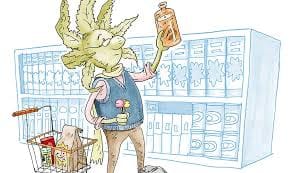In my last blog, I talked about getting to know your CBD topicals. Today, I’d like to address finding the real-deal CBD oil in your topicals. As you may already know, CBD, like essential oils, is not regulated by the Food and Drug Administration (FDA). The market, flooded with CBD topicals, gummies, oil, etc., is ripe for rip-offs. If the FDA isn’t regulating CBD oil, then you need to be your own best advocate. So, let’s take a stroll through what it means to get the best CBD bang for your buck.
CBD 101
Just a quick primer to remind you what CBD is and isn’t. Cannabidiol, or CBD, is one component of the cannabis plant. The extracted oil can help relieve conditions such as pain, arthritis, burns, depression, neuropathy and more.
CBD comes in three categories:
- Full spectrum CBD contains other compounds from the cannabis plant, including cannabinoids, flavonoids and terpenes. It can also contain miniscule amounts of THC.
- Broad spectrum CBD is the same as full spectrum, without the THC.
- CBD isolate is straight-up CBD, no other compounds.
A big benefit of the broad and full spectrum CBD oil is that they produce an entourage effect. Meaning the benefits of all the compounds working together make the product stronger and more effective. CBD isn’t psychoactive so it won’t get you high.
What to look for in CBD oil
First, be sure CBD oil comes from organically grown hemp. Find out where the cannabis or hemp originated. How it was grown, and the species; sativa, ruderalis or indica. Hemp easily accumulates toxins in the soil. If the growing environment isn’t clean, your CBD probably isn’t either. One of the best sources of CBD is organic-certified, hemp-grown farms in pristine regions of Europe. If you can find it, U.S.-grown hemp can be a good source, too. The U.S. requires farmers to be certified by state departments of agriculture. Check a company’s website or inquire with its customer service to get that information.
Second, find out how it was manufactured. Ask how the company extracts the CBD from the cannabis plant. If these toxic chemicals are present in extraction – propane, hexane, pentane and butane, which are flammable hydrocarbon gases found in petroleum – walk away. Fast. Two healthful extraction methods are done with organic, pharmaceutical-grade ethanol or a process called supercritical CO2 extraction. Look for that instead.
Next, you’ll want to check the purity. Is the CBD made from the whole plant? Look for a label that says whole plant or full spectrum. Using the whole plant ensures that the oil contains CBD as well as a full range of primary and secondary parts of the hemp plant. These include terpenes, flavonoids and other cannabinoids that enhance the CBD, making the benefits exponentially higher than with CBD alone.
Third-party testing
Finally, the best way to know you’re getting the real-deal CBD you want the oil tested by a third-party independent lab. A product should be tested by a third-party lab to ensure that the CBD is what its label claims.  A company willing to undergo scrutiny by an independent lab has nothing to hide. Look for high levels of CBD, with trace levels of several other cannabinoids such as CBV, CBG and CBN to name a few. There should also be test results for potential impurities such as solvents, pesticides and heavy metals to ensure a safe product. Reputable companies will disclose their lab results if you ask or may even put it right on the products.
A company willing to undergo scrutiny by an independent lab has nothing to hide. Look for high levels of CBD, with trace levels of several other cannabinoids such as CBV, CBG and CBN to name a few. There should also be test results for potential impurities such as solvents, pesticides and heavy metals to ensure a safe product. Reputable companies will disclose their lab results if you ask or may even put it right on the products.
At Lost Remedy, the oil we use in our topicals meets all of the criteria.
What’s different about CBD topicals?
As the name implies, you apply CBD topicals to the skin. They come in the form of balms, lotions and salves. A CBD topical stands out as the safest method for using CBD. Rarely will a side effect occur with a topical. Allergies to the other ingredients are generally the cause if there is a side effect. So, check the other ingredients in the product to find out if you’re allergic to any of them.
CBD topicals work well for pain, inflammation and hydrating dry skin. When you apply CBD to your skin, it penetrates deeply, stopping short of the blood stream. Deep in the tissue, it binds with receptors and works to alleviate pain or other skin conditions.
While it’s true that other ways of using CBD can help certain conditions, in cases where there is pain or a skin condition, topicals act the most quickly. Many ailments respond well to topical because of its fast-acting ability.
Chronic pain, joint and muscle pain from overexertion or injury, arthritis pain and nerve pain respond well to CBD because of its anti-inflammatory properties. In the case of burning from radiation in cancer treatment, a CBD burn topical can protect the skin from the brutal burning that often accompanies the treatment.
Skin conditions such as acne, rash, eczema and psoriasis are also candidates for CBD. Speaking of skin, CBD beauty creams and lotions are a great way to hydrate and nourish your skin. Lost Remedy uses no toxic substances or chemicals in our topicals, just CBD, essential and carrier oils.
